Reviews
Oct 7, 2019

Whenua Hou: A New Land
Nā Neville Peat
Whenua Hou Komiti/
Department of Conservation 2019
RRP: $25.00
Review nā Matthew Walker
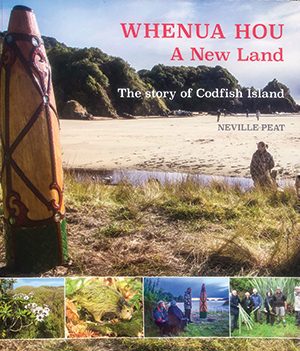 In July TE KARAKA staff were privileged to attend the launch of this pukapuka at Te Rau Aroha Marae in Awarua. This was a wonderful opportunity to acknowledge the partnership between the Whenua Hou Komiti and the Department of Conservation that brought this book to life. The island of Whenua Hou lies just off the coast of Rakiura, and is of great significance to Ngāi Tahu as the location of the first permanent mixed Māori and European settlement in Aotearoa. It is also the home of the Kākāpō Recovery Programme today, and this book honours both the historical and contemporary stories of the island. Fittingly, our reviewer has a close relationship with the island of Whenua Hou, both as a descendant of that early settlement, and as a former volunteer for the Kākāpō Recovery Programme.
In July TE KARAKA staff were privileged to attend the launch of this pukapuka at Te Rau Aroha Marae in Awarua. This was a wonderful opportunity to acknowledge the partnership between the Whenua Hou Komiti and the Department of Conservation that brought this book to life. The island of Whenua Hou lies just off the coast of Rakiura, and is of great significance to Ngāi Tahu as the location of the first permanent mixed Māori and European settlement in Aotearoa. It is also the home of the Kākāpō Recovery Programme today, and this book honours both the historical and contemporary stories of the island. Fittingly, our reviewer has a close relationship with the island of Whenua Hou, both as a descendant of that early settlement, and as a former volunteer for the Kākāpō Recovery Programme.
Te Waikoropupū/Sealers Bay is beautiful. I stood here on these golden sands a few years ago, taking a few minutes out between a hectic schedule of day and night-shift kākāpō work. Dusk in summertime comes late to Whenua Hou. When it does come, the toothy granite outcrops of the Ruggedy Range glow salmon across the water as Earth’s shadow rises to claim them back. Try to guess how far: so hard to tell. A hoiho passes, watchful, taking its time, heading out to feed. A timeless spot, untouched by the hands of people. Or so I thought – but I was wrong about that. I was standing in the footprints of my tūpuna.
Turning away from the beach and heading up the sandy path, the clues – the “tuwhiri”, as Neville Peat describes – are everywhere. The dead trunks of tōtara in the creek nearby bear scars where bark was peeled away and used. The pū harakeke just up from the beach are not native to Whenua Hou: they were brought here by Ngāi Tahu women as a resource, for raraka, for kai, for rokoā. And I find them right there in my old photographs, tohu I could not yet read. Beneath the surface, the beach reveals a history of occupation back to the 13th century. Deep layers speak of a world of Waitaha penguins and moa, of trade from afar: 15th century obsidian from the Bay of Plenty. Shallower layers speak of pre-Treaty contact: willow pattern plates, pipes, buttons, pounamu. Archaeological work continues.
Whenua Hou: A New Land is a short book for a small island with a big story. This book explores the history, biodiversity, and the critical importance of the island to science, to conservation, to Ngāi Tahu. Nevertheless, if you pick up this book as an uri of Whenua Hou, you may be disappointed. It may not have everything you are looking for. You will not find detailed individual histories of the characters here, the Pākehā sealers and whalers and the Ngāi Tahu women. But you will find a portrait of your tūrakawaewae, a readable overview that captures the spirit of the motu, the spirit of coming together, of mutual benefit, of opportunity, of freedom, of new beginnings. The threads, the whītau, of Whenua Hou are woven through and bound into the whakapapa of Ngāi Tahu today. To me, ultimately, Whenua Hou is a symbol of hope – hope for the kākāpō, hope for collaboration, hope for mutual understanding, hope for mahi tahi. As Whenua Hou is a taoka, so is this book. I bought copies for each of my tamariki. One day, they too will stand on that beach, and they will see what I couldn’t see.
 Matthew Walker (Ngāi Tahu, Kāti Māmoe) is a web developer for Ngāi Tahu Tourism, and a keen tramper, amateur geologist and native orchid botherer. Matthew lives in Ōtautahi with his partner Sarah and his tamariki, Zia and Caspar.
Matthew Walker (Ngāi Tahu, Kāti Māmoe) is a web developer for Ngāi Tahu Tourism, and a keen tramper, amateur geologist and native orchid botherer. Matthew lives in Ōtautahi with his partner Sarah and his tamariki, Zia and Caspar.
Te Whatu Tāniko – Tāniko Weaving: Technique and Tradition
Nā Hirini Moko Mead
Oratia Media 2019
RRP: $45.00
Review nā Paula Rigby
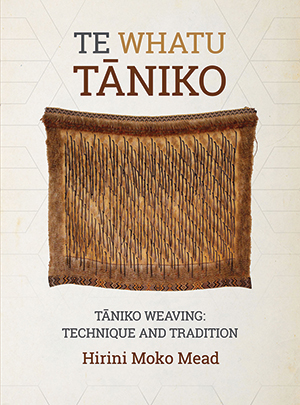 As a young girl I marvelled at my grandmother’s fingers moving deftly across her weaving, swapping the different coloured shimmery silks to form patterns that she created into belts, bags, and headbands. I was later to learn that this weaving was called tāniko. When my grandmother died, I came across this book, and it became my “go to” inspiration, and the answer to the many questions on the subject of tāniko I was no longer able to ask her.
As a young girl I marvelled at my grandmother’s fingers moving deftly across her weaving, swapping the different coloured shimmery silks to form patterns that she created into belts, bags, and headbands. I was later to learn that this weaving was called tāniko. When my grandmother died, I came across this book, and it became my “go to” inspiration, and the answer to the many questions on the subject of tāniko I was no longer able to ask her.
Tā Hirini Moko Mead’s book is recognised as a key reference work to this important tradition of Toi Māori. It was first published in 1958, this being edition three. It is a comprehensive reference book for artists, enthusiasts, weaving students, and teachers.
If you have ever wanted to know anything about tāniko, it is all here in one book: the origins of tāniko weaving, its development from the Classical Māori period AD 1650 to 1800 through to the Modern Māori period of 1900 to present day, and traditional techniques are all shown and explained. For those who would like to give it a go, there are step-by-step instructions and drawings alongside a variety of graphed-out patterns for you to try, including recommendations for the amount of materials you will need to make a sampler.
Although first published in 1958, there has not been another book dedicated to tāniko that has surpassed this one. I still get enjoyment from reading this great book.
 Paula Rigby (Ngai Tūāhuriri) is a skilled weaver, with many years of experience. She is currently Deputy Chair of Te Rōpū Raranga Whatu o Aotearoa (National Weavers Committee). Paula has been commissioned to make taonga pieces for both international and national collections.
Paula Rigby (Ngai Tūāhuriri) is a skilled weaver, with many years of experience. She is currently Deputy Chair of Te Rōpū Raranga Whatu o Aotearoa (National Weavers Committee). Paula has been commissioned to make taonga pieces for both international and national collections.
The New Zealand Wars – Ngā Pakanga o Aotearoa
Nā Vincent O’Malley
Bridget Williams Books 2019
RRP: $39.99
Review nā Gerry Te Kapa Coates
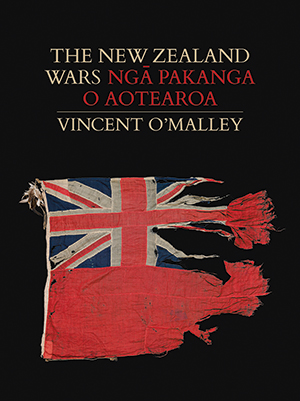 The New Zealand Wars involving Māori conflict with the colonising British Empire spanned the years from 1845 to 1872, touching on many 19th century aspects of life in this country. The wars have never been fully acknowledged for the wide effects they had on both tangata whenua and the settler society that arose from colonisation. In this book historian Vincent O’Malley says that “awareness and knowledge of this history is crucial to fully understanding the present”, and that “any discussion of contemporary Māori poverty that fails to acknowledge the long history of invasion, dispossession, and confiscation is missing a vital part of the story.”
The New Zealand Wars involving Māori conflict with the colonising British Empire spanned the years from 1845 to 1872, touching on many 19th century aspects of life in this country. The wars have never been fully acknowledged for the wide effects they had on both tangata whenua and the settler society that arose from colonisation. In this book historian Vincent O’Malley says that “awareness and knowledge of this history is crucial to fully understanding the present”, and that “any discussion of contemporary Māori poverty that fails to acknowledge the long history of invasion, dispossession, and confiscation is missing a vital part of the story.”
O’Malley gives us chapter and verse of this history, grouped into sections including The Northern Wars 1845–46, Central New Zealand: Wairau, Wellington, and Whanganui, The Taranaki War 1860–62 and 1863–64, The Waikato War 1863–64, The War at Tauranga, Pai Mārire and the West Coast campaigns 1864–66, The East Coast Wars 1865–66, Titokowaru’s Campaign 1868–69, and The Pursuit of Te Kooti 1868–72. He summarises the legacies of these various wars by talking about the moves towards redress, how the wars are remembered – or not – by the two factions, and showing the disparity between the government funds lavished on World War I commemorations, compared with those for wars fought here in New Zealand between the Crown and Māori.
It is mainly young people who have been leading the movement to ensure that New Zealanders remember this history. One example quoted is the three students from Ōtorohanga College who, after having visited local sites of conflict, drafted a petition to Parliament in 2015 which attracted over 12,000 signatures calling for a national day of commemoration of the New Zealand Wars. The resulting Māori Affairs Committee inquiry attracted 189 submissions, of which three quarters opposed the petition. Those who opposed were predominantly elderly and “disproportionately male.” In August 2016, the government announced that a national day of commemoration would be established, although it would not be a public holiday. After a false start in October 2017, the first Rā Maumahara (day of remembrance) was finally held on 11 March 2018, with the intention for future commemorations to be held on 28 October each year, the anniversary of the Whakaputanga – the 1835 Declaration of Independence by Māori.
One purpose of the book is to aid teaching this history in schools. It is very readable, with fine half-page illustrations – photographs taken of those of the times, both historic and recent artwork, and maps of conflict areas. Class sets should be mandatory in New Zealand schools.
The current protests around Ihumātao are noted with an illustration on page 109 of a published Crown ultimatum notice dated July 9 1863: “To the Natives of Mangere, Pukaki, Ihumatau, Te Kirikiri, Patumahoe, Pokeno and Tuakau – All persons of the Native Race living in the Manukau district and the Waikato frontier are hereby required immediately to take the Oath of Allegiance to her Majesty the Queen, and to give up their arms to an officer appointed by the Government for that purpose.” O’Malley says in a footnote that many Māori understood this notice as ordering them to leave their lands, and that few were willing to take the oath, as they feared they might then be required to fight for the Crown against their own kin.
This book is splendidly produced. Not only is it timely, but it will certainly endure as an accessible resource for those interested in learning about the true history of Aotearoa from both sides’ perspective.
 Gerry Te Kapa Coates (Ngāi Tahu, Waihao) was born in Ōamaru, and has had poems, book, and theatre reviews and stories in Huia Short Stories collections 4, 5, and 7; and other publications including Landfall, Mana magazine and Ora Nui 3, as well as a wide variety of non-fiction espousing environmental issues, amongst other themes. His collection of poems and short stories from 1961–2011, The View From Up There, was published by Steele Roberts. Gerry was a panellist at the 2013 Christchurch Writers and Readers Festival. He also works as a consultant and commissioner on RMA and similar EPA hearings, as well as being an author and doing Māori and technology advisory work.
Gerry Te Kapa Coates (Ngāi Tahu, Waihao) was born in Ōamaru, and has had poems, book, and theatre reviews and stories in Huia Short Stories collections 4, 5, and 7; and other publications including Landfall, Mana magazine and Ora Nui 3, as well as a wide variety of non-fiction espousing environmental issues, amongst other themes. His collection of poems and short stories from 1961–2011, The View From Up There, was published by Steele Roberts. Gerry was a panellist at the 2013 Christchurch Writers and Readers Festival. He also works as a consultant and commissioner on RMA and similar EPA hearings, as well as being an author and doing Māori and technology advisory work.
Whitiki! Whiti! Whiti! E! Māori in the First World War
Nā Monty Soutar
David Bateman Ltd 2019
RRP: $69.99
Review nā Russell Caldwell
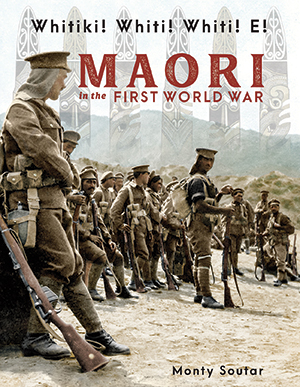 Whitiki! Whiti! Whiti! E! Māori in the First World War is a densely-packed and utterly absorbing work by leading Māori military historian and former soldier, Dr Monty Soutar (Ngāti Porou, Ngāti Awa), ONZM. Dr Soutar specialises in Māori military history in both World Wars, and his new book follows his previous award-winning title, Ngā Tama Toa: The Price of Citizenship: C Company 28 (Māori) Battalion 1939–1945.
Whitiki! Whiti! Whiti! E! Māori in the First World War is a densely-packed and utterly absorbing work by leading Māori military historian and former soldier, Dr Monty Soutar (Ngāti Porou, Ngāti Awa), ONZM. Dr Soutar specialises in Māori military history in both World Wars, and his new book follows his previous award-winning title, Ngā Tama Toa: The Price of Citizenship: C Company 28 (Māori) Battalion 1939–1945.
Whitiki! is very well organised and easily comprehensible. The author’s clear style signposts the reader through major historical events, as well as fleshing out the story of World War I and the role of Māori in it. From a population of 50,000, more than 2200 Māori served in the war, and more than 330 died. They served in the Middle East, Malta, Gallipoli, France, Belgium, and England from 1914 to 1919, in the Māori Contingent and its successors.
The book explores life in Māori communities before the war through to embarkation overseas. Unit formation, training, the realities of trench warfare, and the roles of the Māori soldiers on the front line are also examined. Light is also shed on the reasons why some Māori men signed on to serve, and others staunchly resisted the call to fight overseas. At nearly 600 pages, this book is a significant work. It is packed full of information, detailed research, and over 300 images, many from whānau collections which have not previously been published.
The book also serves as a reference source for the more experienced researcher. It is easy to quickly find parts of the book relevant to one’s own iwi or hapū, or in many cases, whānau. In the case of Ngāi Tahu, Whitiki! has drawn on the rich material contained within He Rau Mahara, published in 2017 by the Ngāi Tahu Whakapapa Unit.
Whether it be on the beaches and hills of Gallipoli or fighting in the trenches in Europe, Māori forces were at the forefront of some of the most gruelling war conditions imaginable. Whitiki! contains a vivid first-hand example of this from Private Wiremu Pitama (from Tuahiwi) of burying fallen comrades while under enemy fire at Gallipoli:
“The Turks were sniping at us all the while … we couldn’t dig a decent hole, the ground being that hard … we could only get down three feet … we buried them as they were with their things on … Wepiha read the burial service. We were all crouching to avoid the bullets.”
During World War I the devastating artillery bombardments were punctuated with quiet moments. At those times, relentless banter, camaraderie, and a satirical sense of humour helped Māori soldiers to pass the time, support each other, and make life a little more bearable. Whitiki! also depicts those moments when the Māori soldiers yearned for home comforts and loved ones. The sparse rations also had them longing for kai Māori.
“I should like to be home and have a good feed of mutton birds and potatoes,” Private William Rickus of Temuka wrote home to his mother. “I often crave for a native meal, such as corn, kanakana (lamprey), fowls, or anything for a change from those war rations.”
It is clear from the cases presented in this book that Māori in the First World War played a key role in the evolution of uniquely New Zealand styles of soldiering and leadership. This can be seen in the fusion of European military training and the Māori approach to battle. Brave Māori officers such as Captain John Charles Tamanuiarangi Tikao from Rāpaki gained reputations as fierce fighters. When describing an attack on Chunuk Bair Ridge, Tikao wrote, “I had hardly got the word charge out … when my men were into it hell-for-leather”.
When Tikao issued the order to charge, his soldiers broke into haka: “Ka Mate! Ka mate!” (Will I die!) and “Ka Ora!
Ka ora!”(Will I live!). “The yelling screaming way … the whole lot of us … as we ran at the Turks … they seemed bewildered for they hardly fought at all. Most of them ran.”
Tikao’s men admired his approach of leading from the front during close quarters combat. “You have no idea what an amount of confidence it gives one when you know you have a good leader,” one of his men said.
Monty Soutar has done an outstanding job in achieving his mission of ensuring that all of our tūpuna soldiers are not forgotten. The research for this book was conducted over four years; nearly as long as the war itself. The result is a superb and groundbreaking job of telling the story of the entire Māori war effort in the First World War. The book is a welcome addition and fitting capstone to the series on New Zealand and the First World War produced jointly by Manatū Taonga, the Ministry for Culture and Heritage, Massey University, and the New Zealand Defence Force, Te Ope Kātua o Aotearoa.
 Russell Caldwell (Ngāi Tahu/Te Arawa) manages a youth justice facility in Christchurch. He has worked in a number of senior roles in government and Māori organisations, including 10 years working for the Ngāi Tahu Māori Trust Board and Te Rūnanga o Ngāi Tahu. He has previously served as an infantryman and signaller in the New Zealand Army, a second lieutenant in the New Zealand Army Cadets, and a specialist service officer in the Australian Army Cadets, Northern Territory Battalion. Russell holds a degree in New Zealand History and a Master’s degree in business. He has published works on the New Zealand Wars and Ngāi Tahu Whakapapa.
Russell Caldwell (Ngāi Tahu/Te Arawa) manages a youth justice facility in Christchurch. He has worked in a number of senior roles in government and Māori organisations, including 10 years working for the Ngāi Tahu Māori Trust Board and Te Rūnanga o Ngāi Tahu. He has previously served as an infantryman and signaller in the New Zealand Army, a second lieutenant in the New Zealand Army Cadets, and a specialist service officer in the Australian Army Cadets, Northern Territory Battalion. Russell holds a degree in New Zealand History and a Master’s degree in business. He has published works on the New Zealand Wars and Ngāi Tahu Whakapapa.
Kei hea a Spot?
Nā Eric Hill
Penguin 2019
RRP: $19.99
Review nā Allanah Burgess rātou
ko Kaia Waaka (4), ko Maika Waaka (3)
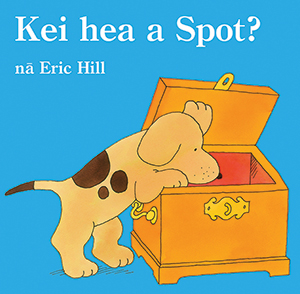 What an awesome way to take an original lift-the-flap book to the next level – publish it in te reo Māori!
What an awesome way to take an original lift-the-flap book to the next level – publish it in te reo Māori!
My tamariki recognised the book straight away. It’s one of our favourite stories, and we think it’s pretty cool that it’s now available in te reo.
The Spot series is well known and holds a fair bit of space in our book shelves. In this translation we found that although most of the reo is at a beginner level, some of the sentences are harder than others. You don’t need to worry, because most people are probably familiar with the English version, or can easily work out the meaning because of the great illustrations!
Kaia is very proud that she is now able to say “Kei hea?” and understands it means “Where is?”
Some other kupu hou my tamariki learned were kāo (no), āe (yes), and pea (maybe).
Kei hea a Spot? is an interactive and fun way to introduce some basic kupu to your tamariki, and allows them to develop propositional language such as “Kei muri pea i te tatau?” (behind the door), “Kei roto rānei i te karaka?” (inside the clock), and “Kei raro pea i te moenga?” (under the bed).
Lifting the flaps means fun and unexpected surprises for everyone. When Maika was asked what he thought of the book, he said, “Oh, good! The bit when ‘Kāo, Spot isn’t in the treasure’ when I opened it.”
I won’t reveal where Spot is at the end of the book but let’s just say that Kaia went on to support Maika’s kōrero by adding, “I think it’s a surprise to everyone when Spot isn’t under the whāriki like we all thought!”
Kaia said that this book makes her feel happy, but she doesn’t like when Maika reads it because he isn’t very careful and bends the flaps. And she’s right, he is a little aggressive when it comes to opening the flaps; which unfortunately means I don’t expect the book to stay in very good condition for long.
This classic book published in te reo Māori is a must-have for your toddlers’ book collection. I hope my tamariki don’t begin hiding from me at dinner times, but I am looking forward to playing hide and seek using our kupu hou.
 Allanah Burgess (Ngāi Tahu, Te Ātiawa) is a project adviser for Whakapapa Ngāi Tahu and a proud māmā to her two tamariki Kaia (4) and Maika (3) Waaka. They live in Ōtautahi but call Waikawa ki Te Tau Ihu home. Kaia is a creative kōtiro who has a love for pukapuka, art and role play. She loves spending holidays with her whānau in Waikawa, especially visiting her Nani, Koro and many cousins.
Allanah Burgess (Ngāi Tahu, Te Ātiawa) is a project adviser for Whakapapa Ngāi Tahu and a proud māmā to her two tamariki Kaia (4) and Maika (3) Waaka. They live in Ōtautahi but call Waikawa ki Te Tau Ihu home. Kaia is a creative kōtiro who has a love for pukapuka, art and role play. She loves spending holidays with her whānau in Waikawa, especially visiting her Nani, Koro and many cousins.
Opinions expressed in REVIEWS are those of the writers and are not necessarily endorsed by Te Rūnanga o Ngāi Tahu.